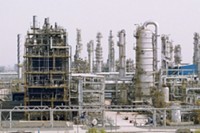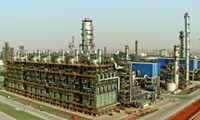Advertisement
Grab your lab coat. Let's get started
Welcome!
Welcome!
Create an account below to get 6 C&EN articles per month, receive newsletters and more - all free.
It seems this is your first time logging in online. Please enter the following information to continue.
As an ACS member you automatically get access to this site. All we need is few more details to create your reading experience.
Not you? Sign in with a different account.
Not you? Sign in with a different account.
ERROR 1
ERROR 1
ERROR 2
ERROR 2
ERROR 2
ERROR 2
ERROR 2
Password and Confirm password must match.
If you have an ACS member number, please enter it here so we can link this account to your membership. (optional)
ERROR 2
ACS values your privacy. By submitting your information, you are gaining access to C&EN and subscribing to our weekly newsletter. We use the information you provide to make your reading experience better, and we will never sell your data to third party members.
Business
It's All Happening down at the K
by ALEXANDER H. TULLO, C&EN NORTHEAST NEWS BUREAU
November 8, 2004
| A version of this story appeared in
Volume 82, Issue 45

Late last month in Düsseldorf, Germany, "K" stood not for potassium but for Kunststoff and Kautschuk, the German words for plastics and rubber, respectively.
From Oct. 20 to 27, the city's sprawling Messe Düsseldorf convention center hosted the K 2004 plastics and rubber fair. The triennial event is the largest trade show of its kind in the world, occupying all of the Messe's 18 exhibition halls and hosting some 2,914 exhibitors and 230,000 visitors.
Attendees could walk a quarter of a mile or more through the exhibits of plastics, plastics additives, and machinery. Underground railcars and taxis in the city were emblazoned with the Dow Chemical diamond logo, and inside these conveyances, it was common to overhear people talking about plastics. The event was even bigger than K 2001, which had 2,872 exhibitors and 228,000 visitors.
When asked, exhibitors and attendees answered unanimously that the atmosphere at K 2004 was decidedly more upbeat than it was at K 2001, which was held in one of the worst years ever for the plastics industry. This year, plastics makers are seeing strong sales volumes and are turning profits again. The only reservations expressed by people at the show were over high oil and natural gas prices, which they fear will undermine economic growth.
Bob Engle, North American business director for the engineering plastics maker Ticona, said he has seen high single-digit growth in volumes in his business so far this year, although that growth is now slowing to a 3 to 4% rate. "I don't see it as a manufacturing slowdown," he said. "I see us slowing back down to normal rates."
There was also a lot of excitement at the show over technology. Companies at every trade show unveil a lot of incremental technological advances, but, at K, more than a few showed off something genuinely new. "The general mood seems to be pretty upbeat about the amount of innovation going on," said Robert W. Johnston, global polypropylene marketing and sales manager at ExxonMobil Chemical.
At its enormous stand, Bayer MaterialScience furnished a room with a Dolby 5.1 purSonic sound system. Instead of using speaker cabinets, the system was built directly into the walls--and the pictures hanging from the walls--using polyurethane sounding boards developed by Bayer, Siemens, and polyurethane fabricator Puren. In order for the boards to resonate as a speaker does, the hardness of the foam and the size and shape of the foam's cells have to be just right.
Not to be outdone, Ticona showed off a similar technology in a sound system developed by the Finnish firm Panphonics. The system consists of a sheet of Ticona's Topas cyclo-olefin copolymer, two sheets of nonwoven polypropylene fabric, and electronic components. The Topas is statically charged, and an electric field is then applied to it, resulting in a speaker no thicker than a piece of corrugated cardboard. A potential market is sound systems installed in car ceilings.
Ticona also showcased fuel-cell stacks it helped develop with SGL Carbon and Celanese spin-off Pemeas. The 2-kW proton-exchange membrane stacks can cost only $1,000 per kW to produce, versus the $3,800 per kW for previous stacks. The European Union has set targets of about $640 per kW by 2010. The design incorporates graphite-filled liquid-crystal polymers and polybenzimidazole membranes supplied by Pemeas.
In addition to new applications of existing materials, plenty of chemistry-based developments debuted at the show.
Wacker Silicones unveiled Geniomer, called the first thermoplastic silicone elastomer. Jürgen Küpfer, Wacker's project house manager for hybrid and advanced materials, helped develop the thermally moldable polydimethylsiloxane/urea copolymers, which can be used as processing aids for polyolefins.
Another potential market is surface modification, where Geniomer can be coextruded with other plastics or coated onto fabrics to lend silicone properties. Finally, Küpfer said, Wacker is looking at plasticizer-free medical tubing made from Geniomer. "We know this product will be very successful in the thermoplastics industry," he said.
Solvay Advanced Polymers launched Supradel HTS, billed as the "first totally new sulfone-based polymer to be introduced commercially in the last 15 years." The aromatic sulfone has a glass-transition temperature of 255 °C, giving the resin the highest heat resistance of any transparent amorphous thermoplastic polymer on the market, the company says. Solvay is eying typical high-end engineering polymer sectors such as aerospace, automotive, electrical, and industrial markets.
Univation Technologies, the polyethylene process and catalyst joint venture between Dow and ExxonMobil, launched a catalyst technology for producing bimodal high-density polyethylene (HDPE) in a single Unipol-process reactor. Normally, a series of reactors are needed to produce bimodal resins.
Univation is able to accomplish this by putting two different single-site catalysts on a single carrier. The catalysts' first application is in bimodal HDPE films. Dirk Van der Sanden, Univation's market planner, said the venture will next use this "engineered catalyst" approach for bimodal HDPE for pipe applications and, eventually, for novel linear low-density polyethylene.
A GRASSROOTS Unipol reactor equipped with the system is 40% cheaper than a multiple-reactor system, Univation claims. The catalysts can be retrofit into existing reactors at a modest cost. Van der Sanden said keeping capital costs low is critical as polymer producers in regions such as Asia and Latin America look to make more sophisticated products. "The industry is becoming more and more global, which means you have to be more cost-effective," he said.
Globalization of the polymer industry was another focus at K 2004. "India is poised to be, by the end of the decade, one of the top five polymer-consuming countries in the world," said Mukesh Ambani, chairman of Reliance Industries, speaking to reporters. The company expects that per capita plastics consumption in India, now only 4 kg per year, will double by 2010.
Reliance, the big wheel of the Indian petrochemical industry, is planning $2 billion in new investments over the next five years, building plants for polyester, ethylene glycol, purified terephthalic acid, polypropylene, styrene, and butadiene. In addition, the company is looking beyond India. Ambani said Reliance is "seriously" looking at acquiring Basell, which BASF and Shell Chemicals recently put up for sale.
Mohammad Reza Nematzadeh, president of Iran's National Petrochemical Co., is also interested in Basell. "Our new policy is to gradually go for investment outside of Iran," he told an audience at the show. However, even though Basell has extensive U.S. assets, he answered "No" when asked by C&EN whether the U.S. sanctions on Iran would pose a problem for such a purchase.
Saudi Basic Industries Co. (SABIC) is also considering more investments outside of Saudi Arabia. The company is mulling two potential projects in China, according to Mohamed Al-Mady, vice chairman and chief executive officer. One of these projects would include a refinery and an ethylene cracker; the other would involve expansion of an existing facility.
Al-Mady also reiterated that instead of seeking an acquisition in North America, SABIC is interested in participating in a naphtha-based ethylene cracker project in Mexico with Mexican national oil company Pemex. Nova Chemical recently signed onto one of two ethylene complexes that Pemex has proposed. "If you are not in North America," Al-Mady said, "you are not a completely global company."
In addition, SABIC may make a decision early next year on a new ethylene cracker in Geleen, the Netherlands, and may soon move forward with a polyethylene expansion in Gelsenkirchen, Germany.
Speaking of Gelsenkirchen, executives planning on attending K 2007 should start thinking about hotel rooms now, or they may end up staying there instead of in Düsseldorf, as this C&EN reporter did. Gelsenkirchen is far enough from the Messe that the trains don't run all night, and Düsseldorf cab drivers need to consult their global positioning systems to get there.




Join the conversation
Contact the reporter
Submit a Letter to the Editor for publication
Engage with us on Twitter